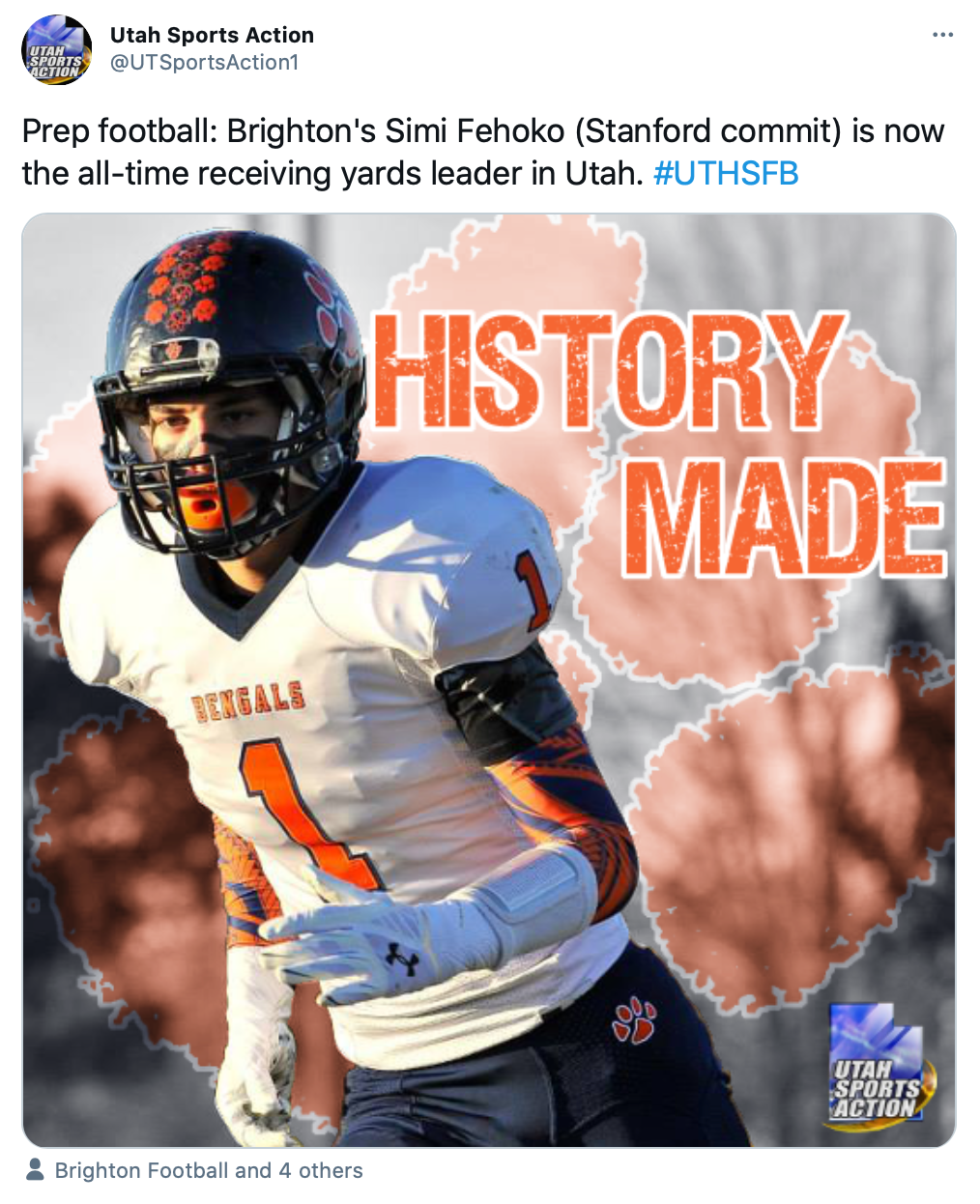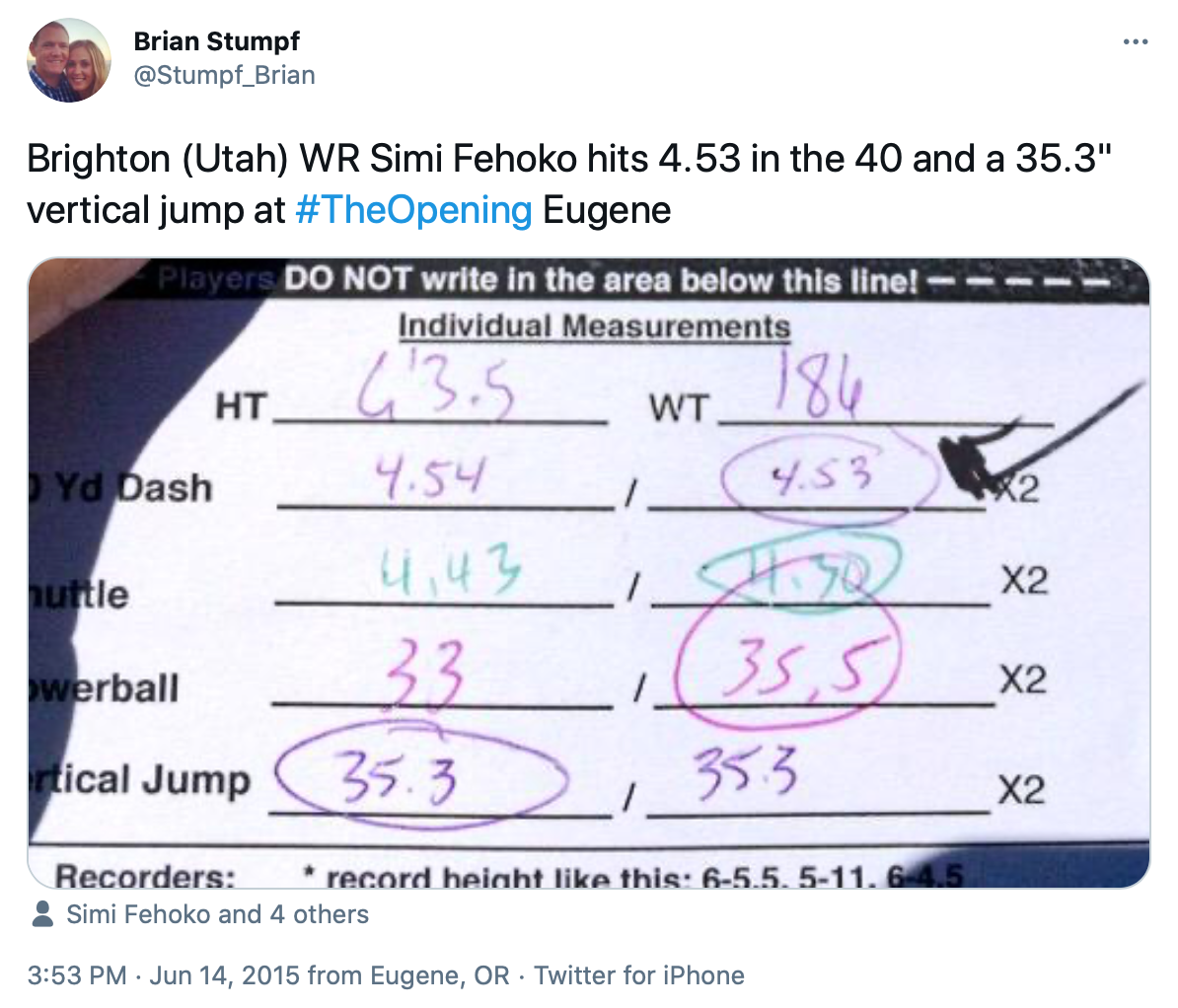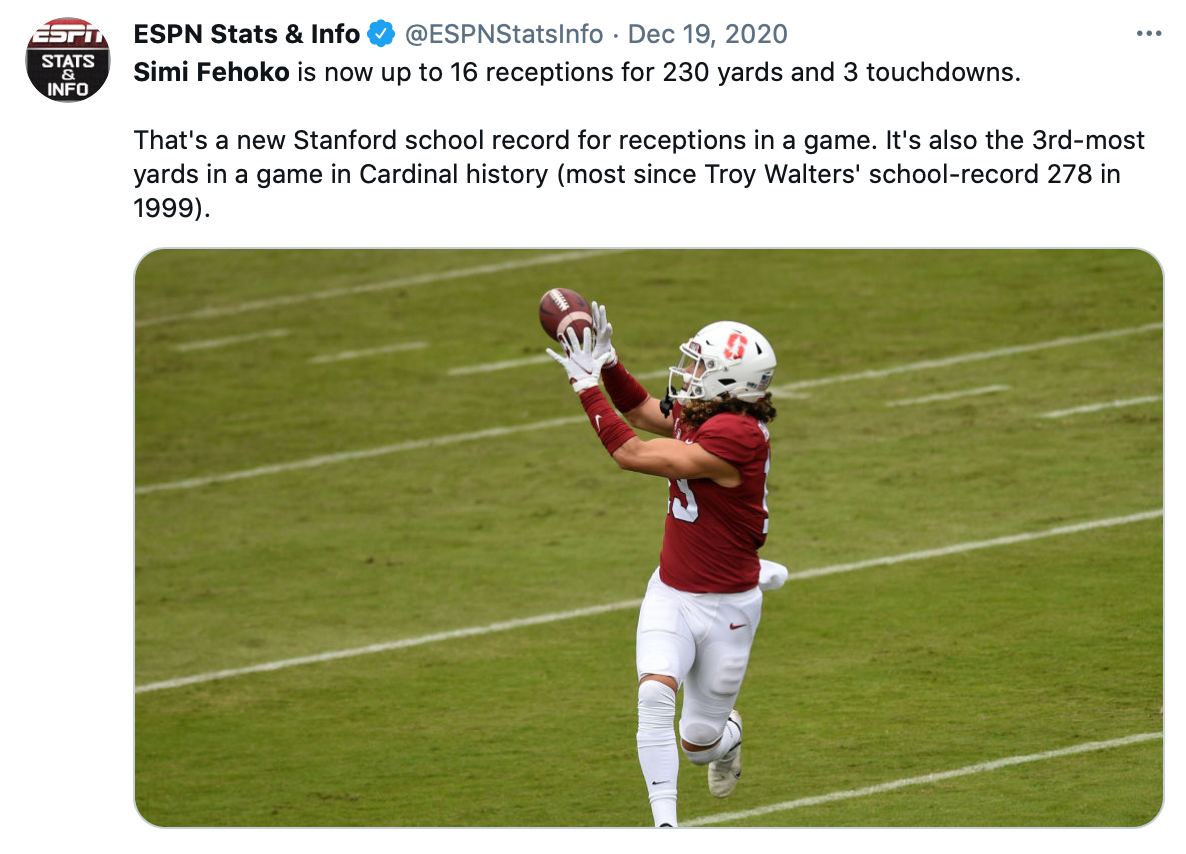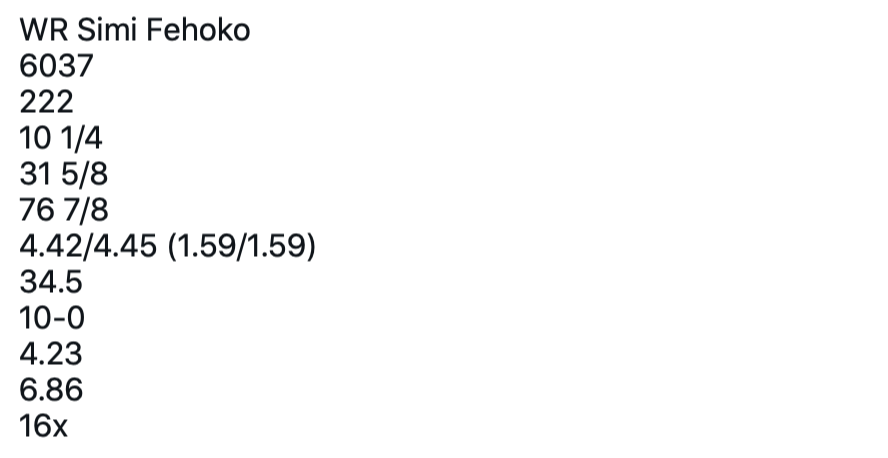Simi Fehoko
WR | Stanford Cardinal | 6-3 | 222 lbs.
Rookie Expectations
Over the last three NFL seasons, wide receivers who predominantly lined up on the outside have run five particular routes for about 75% of total routes. Those five routes are Gos, Hitches, Outs, Slants, and Crossers. For WRs playing from the slot, these five routes are also featured, at slightly altered percentages, for a nearly identical combined total. The final 25% will be distributed among Ins, Posts, Corners, some Screens, and the rest on exotic combo routes when split wide. For slot WRs, the majority of that 25% will go toward Screens and shallow work in the flat. Whenever I make references to “NFL routes” in these Dyno rookie profiles, those are the guidelines I am following.
The Story
To think that it took the neighbors nagging Simi Fehoko’s parents to finally enroll him into the local Brighton Little League at the age of nine to get him into football. We’re not talking about any ordinary 9-year-old; this kid has outstanding football bloodlines coursing through his veins. His father, Simon, played football for the Dixie State Trailblazers of the Western Athletic Conference. Two of his cousins, Alfred Pupunu and Breiden Fehoko, respectively, played and currently play in the NFL with the Chargers. Four other of his cousins also played college football: V.J. Fehoko, Sam Fehoko, T.J. Fehoko, and Whitley Fehoko. Simi’s destination landing on a football field was pretty much set in motion the moment he was brought into the world.
Not that everyone was supportive of Fehoko playing little league football, of course. During the spring of his fifth-grade season, parents from opposing teams used a boundary dispute to get him removed from the little league. Fehoko’s parents very nearly took him out of sports altogether. When cooler heads prevailed, Fehoko was sent down a path that would lead him to play football at Brighton High School. And Simi did not waste any time establishing himself as one of the top WRs to ever play high school ball in Utah, from a statistical perspective. At the age of 14, his junior season with the Bengals, when most kids are spending their days playing Call of Duty, Fehoko pulled in 59 receptions, 1,644 yards, and 24 TDs playing for the No. 6 ranked team in the state. He followed up that performance with 59, 1,495, and 16 to collect the Gatorade POY, MaxPreps POY, and the title as “Mr. Football” in the state of Utah.
You don’t hear of many 16-year-olds competing at the college level, so, after choosing to play ball for HC David Shaw at Stanford, Fehoko delayed his matriculation to serve a two-year Mormon mission in Seoul, South Korea, which was very likely his reasoning behind working diligently to graduate HS so early. He chose Stanford over offers from Clemson, Michigan, Washington, Nebraska, Arizona State, Colorado, Utah, Oregon State, and Washington State. Since Fehoko entered his true freshman year wearing Cardinal at 6-foot-4, and somewhere around 200 pounds, he would redshirt the 2018 season. During his two seasons on the field, Fehoko would play in 22 games (only five starts), collecting 63 receptions, 1,198 yards, and nine TDs.
The Attributes
Prior to choosing Stanford, Fehoko would have vastly different opinions passed around on his scouting reports. Perhaps due to the string bean appearance or the upcoming extensive time devoted to his mission trip, ESPN would end up slotting him as their WR70, and Rivals as their WR61. But 247Sports felt quite differently in rating him as their WR8. That easily stands as one of the most significant margins in opinion that I’ve ever seen on a scouting profile. In 2015 at The Opening Regional, Fehoko ran a 4.52 40-yard dash, 4.12 short shuttle, and posted a 35.9 inch vertical jump. However, that early athletic testing was outdated by (thankfully) adding 36 pounds to his frame by the end of his college career.
He improved his previous 40-yard dash time by a tenth of a second down to 4.42 seconds (78th percentile) and added a 6.86 second 3-cone time (66th percentile) at his Stanford Pro Day on March 18th. The rest of his athletic measurements were not as promising. His below average vertical jump (34.5 inches) and broad jump (120 inches) measurements call his lower-body explosiveness into question. After watching the tape on Fehoko, we are left with more questions as to his future that simply will not be answered with the freakish straight-line speed at his Pro Day.
However, before we get ahead of ourselves, let’s begin the assessment by taking a look at Fehoko during his junior and senior seasons in HS. It doesn’t take one long watching his junior tape to see a distinctive pattern emerge. Fehoko crushed his competition using that straight-line speed to his advantage on vertical routes. One of the most significant complaints on Fehoko from the HS scouting community was a lack of fluidity and flexibility, which ended up telegraphing his routes. You can see obvious examples at 0:23 and 2:39 in the reel. And asking Fehoko to make any sort of cut to his route — even on a corner fade (3:47) — resulted in considerable deceleration.
The circular, winding patterns will not cut it facing top competition. One reason for this issue is due to naturally running so high, rather than exploding into his routes with his knees bent and his upper body forward to store momentum. Look at the Out-and-Up at 4:09: he is clearly lacking in coordination from his significant growth burst. In fairness, some of these issues are explained away due to his age (14). He does possess the footwork to prevent being jammed up at the line, supported by his 3-cone measurement. And, since he also played a significant amount of safety, he is adept at properly diagnosing opposing coverage shells. We have a long-striding youth with decent speed, the vision of a safety, decent jump-ball ability, and a kid also in significant need of WR coaching.
Diving into his senior tape, we want to make some immediate development notes with such a lack of available tape. The footage is a step up from standard definition, but still a bit too blurry to notice much of a difference in size. The Post down the seam at 1:26 and Out-and-Up at 2:22 prove to us that he’s still rounding his patterns. We actually have our first examples of short-stemmed routes (Hitches) at 3:47 and 4:31. But the first is defended by a retreating Cover 3 CB, the second on what appears to be soft man. Nothing appears to have changed developmentally for Fehoko. That’s quite disappointing. It’ll stand as the last significant game action he’ll see for three seasons. What we do have up to this point is an “I’ll run really fast in this direction, you throw it as far as you can” framework.
We could hope to see monumental development from his redshirt freshman season, if the footage was available to the public. And no highlight reel exists since Fehoko only caught a single pass for six yards. During Fehoko’s redshirt freshman season, he failed to record more than a single catch until the sixth game facing Washington. We don’t have the luxury of full-game footage, so we’ll use these highlights of that game. At the 0:19 mark, Fehoko is lined up in the slot left. Elijah Molden is, surprisingly, giving Simi a big man cushion in the Cover 1. It’s an excellent route from Fehoko opposed by a defender with similar speed. However, it is also another of the exact routes we’ve seen from him time-and-again his entire career.
At 0:28, Fehoko is targeted in a goal-to-go (G2G) at the top of the screen on what appears to be a route miscommunication. Even if the design called for Fehoko to sit on a Hitch, he turned in the wrong direction. This was most likely intended to be an End Zone Fade attempting to utilize his height and wingspan. We do get our first close-up shot of Fehoko after that route. He’s added considerable weight to his frame in the three years since we’ve seen him last. A notable omission from all Stanford run plays, Fehoko is not on the field run blocking. His poor perimeter blocking ability will keep him off the field for over 80% of designed runs over his career. As you can see at 2:20 and 4:34, leaving the field on designed runs also removed Fehoko from the play-action equation.
At 1:59 in the video, Fehoko is opposed again by Molden on a nearly identical route. Molden does get his hands on Fehoko, but very late. The results are much the same. Simi would register over half of his yardage in 2019 on Go routes. I’d love to look through the Week 14 Notre Dame game when Fehoko played nearly the entire contest, and received nine targets. But that footage is not available. We’ll finish off viewing his ‘19 season facing Arizona with this Facebook video. In the first clip, Fehoko is clearly a mismatch for Xavier Bell down the seam from the slot. At 0:16, Fehoko is at the top of your screen, in the slot, and running another Go to the end zone. The final play is an End Zone Fade in the coverage of McKenzie Barnes.
Let’s not waste any time, jumping to this video of Fehoko’s final season with Stanford. Simi gets us started on the opening play with a Go opposed by talented Oregon CB Mykael Wright in man. At this point, we expect to see Fehoko do his best work on vertical routes. And Fehoko improved his yardage per route by 45% when facing man coverage during his final season. At 0:18, Fehoko connects down the seam on a skinny post with Daewood Davis and Verone McKinley III in a Cover 3. At 0:41, Colorado is in a spaced-out Cover 6. Fehoko instantly knows he only needs to outrun LB Alec Pell on the designed Post.
We have a real treat at 0:53. We actually see Fehoko on a Slant, also showing us our first example of a sharp cut facing Washington. Rather surprising. It’s back to the well at 1:13 on a Back Shoulder Go against Washington’s Trent McDuffie in Cover 2-Man. Fehoko shows off some excellent concentration on the poorly-placed throw out in front. And he burns both Nahshon Wright and Jaydon Grant on the Flea Flicker at 1:46. It’s increasingly clear that Fehoko footwork makes it very difficult to jam at the line. That skill will serve him very well in the NFL.
Which brings us to Fehoko vs. UCLA in Week 16. The performance stands as the finest of his career, and also the one that I feel will create considerable issues down the line for fantasy aficionados. Prior to facing the Bruins, Fehoko had 21 catches, 354 yards, and zero TDs over five games. On one afternoon in Rose Bowl Stadium, Simi generated 43% of his receptions, 39% of yardage, and 100% of his TDs. The first clip at 2:03 is a Go defended by Mo Osling III. More man coverage from Osling is shown at 2:21 on another rare occurrence, a Hitch. Look past the result. This is very poor technique by Fehoko. Not only does he need to position his body to bring in the throw, he must also shield the defender away. Allowing Osling to splash into the route is not a mistake he will want to make on an NFL field.
The following Crossing route is another first for us from Fehoko. His future NFL team will ask Fehoko to run Crossers more than any other pattern, sans Go routes. Yet Fehoko ran the route on less than 4% of career routes. More than anything, it’s a very poor Cover 3 read by Elijah Gates. Should he work as an NFL slot — which I highly doubt — the designed screen at 2:47 would come into play. Keep in mind, UCLA CBs proved to be one of the bottom-10 units in the Power Five. The first TD of the day is a Back Shoulder Go at 3:00 with William Nimmo Jr. in the vicinity. The second (3:22) is also at the expense of Nimmo in Cover 2 on a skinny post. The third-and-final TD is an End Zone Fade at 3:34.
Fantasy Fit
The amount of respect I have for a kid to devote two of the best years of his life to a cause in which he passionately believes is substantial. That said, the NFL will chew you up and spit you out if you fail to develop or produce. Those two years away from the game could’ve made a massive difference in Fehoko’s game… just as a return for another season at Stanford could’ve provided. What we have are two statistically-explosive HS seasons of vertical routes from a very green youth, and two partial collegiate seasons with middling overall results. Removing his monster game facing UCLA in ‘20 and Weeks 9 and 12 in 2019, Fehoko generated 2.1 receptions, 38.3 yards, 0.1 TDs, and 6.6 FPG during his career. And he will not be anywhere close to an NFL field in blocking situations. That much is guaranteed. That consideration will also remove him from the play action, RPO equation.
What Fehoko does well is best suited to the pre-2000s era of the NFL. He’s a big, straight-line sprinter. He does possess dangerous vertical speed, and that, when combined with plus footwork off the line, is just enough to get a step on man coverage. He gave us next to nothing on crossers, a common issue, but also failed to put in work on Outs. That’s not entirely his fault, since OC Tavita Pritchard rarely called upon the pattern. But the future work he’ll need on that route alone will set him back. In a best-case scenario, Fehoko is a situational deep threat. One NFL team will be unable to resist his straight-line speed. It’s a guarantee.
I don’t think it is necessary to project a fit for Fehoko on an NFL roster. His current game is ill suited for an NFL starting role. I also find it perplexing that he saw so much work out of the slot at Stanford since his production was nearly cut in half compared to out wide. At his size, that tells me that his coaches resorted to scheming mismatches, rather than earning a reputation as a weapon. If that’s where his future lies, a move to TE would serve him best. But that would require an enormous amount of work in the gym, and finding a team willing to sacrifice that amount of time to essentially baby-step his blocking technique. But at 6-foot-3.7, Fehoko would offer game-changing speed as a Move TE with an additional 20-25 pounds of muscle.
The Bottom Line
It’s never my goal to circle a player in red upon evaluation. I would much prefer to give all of the reasons where an individual will succeed in the NFL. But the truth must be laid out. Avoid Fehoko in all drafts, regardless of the format. The only situation I could see value holding onto Fehoko is leagues with the deepest of rosters, shallowest of pools. Could he end up crushing one season in the NFL? Absolutely. His ability on Go routes could always land him in a situation where he ends up catching enough TDs to hold a little value. That said, projecting TDs is not my business model. I can say without a moment of hesitation that Fehoko is not going to be a useful PPR asset anytime in the near future. We are gifted with another deep WR class as a followup to 2020’s impressive group. Focus your time elsewhere.













